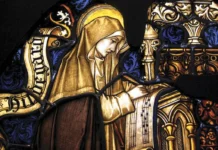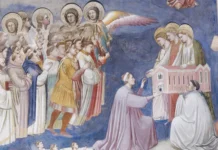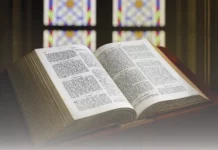Once a symbol ignominy and defeat, the Cross now stands at the centre of Catholic spirituality. It is the distinctive sign of Christ’s followers and the focal point of the aspirations, love, tenderness and respect of a truly Christian soul.
It was the most ominous morning in all of history.
The sun had risen and its heat already radiated over the plaza of the praetorium. The court of this edifice, constructed of multi-coloured stones, was called “Lithostrotos”, Greek for slate ground, or small pile of stones. Nothing warms better than stone heated by the sun. Not even water has the same capacity to absorb heat. There, in the full light of the sun that He Himself had created, God stood to be judged.
However, it was not just the sun’s rays that could be felt. The sun, a blameless and lifeless creature fulfilled its orderly function by God’s command. However, beings endowed with free will often do not make proper use of the gifts bestowed by the Lord of Creation. It was on that morning, as never before in history, that free will was turned with such burning hatred against its Creator.
A Cross dividing history

The sun and stones were faithful to God’s orderly plan. But a Roman governor, who marked history and is called to mind whenever we pray the Apostles Creed, did not follow his conscience and the voice of grace… He knew that he should not condemn Jesus. However, like all those who rationalize the absolute in the Law of God, he wanted to find a compromise between condemnation and adoration.
The multitudes demanded it…
Undoubtedly, people have often acted rightly in demanding the condemnation of a criminal. Nevertheless, if they have at times erred – as must have happened on many occasions – it was never so grievously as on this occasion. Did the multitude act alone? No… The Pharisees and Scribes, with their cry of “Crucify Him! Crucify Him!” incited the crowds to pass a sentence on their Creator which was not only unjust, but deicidal.
Nothing could quell the multitude until the moment when the symbol that would later adorn crowns and steeples entered the plaza. The sign of shame, ignominy and defeat had embarked on its triumphal course through history.
The Cross, embraced by the Divine Redeemer, and borne lovingly upon His adorable shoulders to Calvary, sent a hush through the crowd, dividing it in two. This was symbolic of its historic role. In face of the Cross impiety would mock and piety would venerate; some would ridicule; others would prostrate before it. Some would despise it, while from others it would elicit heartfelt tears; some would tremble from fear at its sight; others would be overwhelmed with love. And so it will continue until that great day when “the sign of the Son of Man will appear in the sky” (Mt 24:30), dividing mankind gathered in the Valley of Josaphat. To the right will be those who will resurrect in their glorious bodies; to the left those who will regain their bodies to suffer greater torments in hell. “He will separate one from another just as the shepherd separates the sheep from the goats. He will place the sheep at his right and the goats at His left” (Mt 25:32-33).
The Cross shall forever stand at the glorious throne of Jesus Christ, transformed from the wood of torture into a tree of light.
The most shameful punishment
In ancient times, the cross was recognized as the most terrible and humiliating of chastisements – “a curse from God”, according to the Book of Deuteronomy (21, 23). It was the public punishment reserved for slaves, malefactors, assassins and thieves. Later, during Roman domination, Roman citizens were exempted by law from this penalty regardless of the gravity of their crime to maintain the dignity of the Empire. And yet, Christ permitted this death for Himself. He assumed the condition of a slave, not only to redeem us from the slavery of sin, but also to make us kings. It was the common punishment for bandits mandated in the penal code and therefore the most terrible.
A physician’s description
According to notable studies of European medical experts of the last century, suffocation is the ultimate cause of death on the cross. Upon being crucified, the victim begins to suffer violent generalized contractions; the face takes on a purple colour and the entire body perspires copiously, especially in the last moments before death. The duration of the agony is approximately three hours. Death occurs after heightened physical struggle and agony.
In his book “The Passion of Our Lord Jesus Christ according to the Surgeon”, Dr. Pierre Barbet affirms: “The whole agony alternated from extenuation to revival, from suffocation to resumed breath. We have the material proof of that in the Holy Shroud, where we can notice a double flux of vertical blood issuing from the wound of the hand, with an angular distance of some degrees. One corresponds to the extenuation position and the other to the revival. It is perceivable that an exhausted individual such as Jesus could not endure that struggle for much longer.”

The mystery of the Cross
From a human and materialistic viewpoint, the Lamb sacrificed upon the Cross appeared abject, mistreated and insulted – a failure and a defeat. Under a supernatural light, however – this being the only true perspective – Jesus was raised upon the Cross like a King on his throne of glory, drawing all creatures to Himself. The Apostles, and St. Paul especially, had a profound understanding of this divine mystery: “I resolved to know nothing while I was with you except Jesus Christ, and Him crucified” (1 Cor 2:2). And he continues: “But may I never boast except in the cross of our Lord Jesus Christ, through which the world has been crucified to me, and I to the world” (Gal 6:14).
Gradual revival of the Cross
The cross retained its terrible stigma for the first Christians, imbued as they were with ancient concepts and traditions. Several centuries elapsed before the first depictions of the crucified Saviour were made. A similar repulsion was felt by many members of the nascent Church who had witnessed relatives suffering similar martyrdoms during the bloody persecutions of the pagan emperors.
Therefore, during the second and third centuries the faithful preferred to adopt the figure of a fish (Ichthys, in Greek), as a representation of Christ. In that symbolization the letters of the word Ichthys form the phrase Iesous Christos Theou Yios Soter, meaning Jesus Christ, Son of God, Saviour. From the Fourth Century onward, after the acceptance and recognition of Christianity by Emperor Constantine the Great, the representation of the fish gradually gave way to the cross as the chosen symbol for adorning sarcophagi, coffers and the like. It eventually became the foremost symbol of Christianity. One of the earliest Western depictions of the sacrifice of Calvary is to be found on the famous cypress door of the basilica of Santa Sabina all’Aventino in Rome, built during the first decades of the Fifth Century.
At that same time, the Sign of the Cross was adopted officially as a Christian prayer, although the pious custom of marking the forehead, the lips and the chest with three successive crosses was already in use. This practice symbolized the placing of the three noblest characteristics of the human person – intelligence, love and strength – under the protection of the cross.

(Details from the Stavelot Triptych, enamel worked in gold, Seventh Century – Metropolitan Museum of Art, New York)
Saint Helen rescues the True Cross
At the beginning of the Fourth Century the holy sites were inexplicably abandoned to such an extent that even the hill of Golgotha was covered with debris. Around this same time, Empress Helen had obtained the conversion of her son Constantine by means of maternal supplication. As an answer to her prayers, the splendid miracle at Ponte Milvio took place ensuring this conversion and the consequent liberation of Christianity (October 28, 312). Moved by a strong impulse of grace, she undertook an arduous trip to Jerusalem with the goal of recovering the True Cross of Our Lord.
Saint Helen delved deeply into the meaning of the mysteries that had just occurred. A luminous cross had appeared in the heavens before the awe-stuck gaze of the Emperor Constantine. It was surrounded by the inscription: In hoc signo vinces (By this sign you shall conquer). Was this not a clear manifestation of the designs of Divine Providence? Was this not a foretelling of the triumphant rebirth of the Church by the scandal of the Cross?
Seeking the Cross would have proven a daunting task for anyone except the elderly yet energetic empress Helen who had not succumbed under financial misfortune or the trials of life. After several weeks of toil, and much excavation – during which she encouraged the workers by her prayer and determination – three crosses were discovered in a trench to the great surprise of witnesses.
However, the problem remained of how to recognize the sacred wood on which the Redeemer suffered His sorrowful agony, bathing it with the last drops of His blood. St. Helen summoned St. Macarius, the Patriarch of Jerusalem who hastened to her aid. He gathered the people and prayed fervently, beseeching the Lord to intervene in verifying the authenticity of the discovery. He then ordered that a poor woman who was beyond the aid of physicians and who was in fact at the brink of death be carried to the site. The ailing woman remained insensible to contact with the first two crosses. But as she touched the third cross, she arose, entirely cured, praising God amidst the joyful cries of the enthusiastic multitude.
These tidings spread quickly through the Christian world and thus began the great devotion to the relics of the Passion.
Returning from her pilgrimage, after having erected several churches in honour of the Passion of Our Lord, the virtuous empress brought with her a sizeable piece of the Holy Cross and the five nails found on that same occasion, giving them as a gift to her son Constantine who ordered that one of the five be placed upon the imperial diadem. Perhaps this was the origin of the beautiful custom of placing a cross on the top of the crowns of Catholic monarchs.

Triumphant arrival of the Holy Cross in Jerusalem
Three centuries after these admirable events, Khosro II, King of Persia, sacked the Holy City, killing a great number of Christians and taking possession of the precious Wood, which figured among the many riches comprising his spoils.
The faithful of the Oriental Church were greatly perturbed to see these treasures of inestimable value in the hands of idolaters. It was then that the Emperor Heracles began a campaign for their recovery. He reclaimed them after 15 years of struggle and adventure, arriving at length in Jerusalem giving thanks to the Lord for the victory.
A great ceremony was organized to receive the Cross with all solemnity and pomp. Faithful from all over gathered to venerate the relic that had been triumphantly recovered. The emperor himself carried the true Cross upon his shoulders in the company of Patriarch Zachary, and surrounded by high-ranking court officials, countless clerics and a fervent multitude. The emperor intended to enter Jerusalem through the gate leading to Calvary, but as he approached the gate, he was unable to move. He had not the strength to take even a single step. Zachary, who accompanied him, indicated to the emperor that his royal and sumptuous garments were not in keeping with Jesus’ example of humility in carrying the Cross through these same streets, wounded and covered with opprobrium. Thus instructed, Heracles, removed the royal insignia and golden crown and donned sackcloth. Walking barefoot he continued his pious procession without further difficulty. The Cross was then triumphantly entrusted to Patriarch Zachary, amidst the rejoicing of a reverent and captivated multitude.
The exact dates of the discovery of the Cross by Empress Helen, and its recovery by the august Heracles are unknown, but for centuries throughout the Christian West, the finding of the Holy Cross has been celebrated on May 3 and its Exaltation on September 14.
The Cross, sign of salvation
Gradually, from amidst a putrefying and pagan decadence, a new world, shaped by the cross emerged. It was a world bathed by the pure and flaming light of the doctrine of the Gospels. It was illuminated in a mysterious and suave manner, by the dulcis praesentia (sweet presence) of He, who from the height of the Cross, with His divine face covered with wounds and spittle, uttered from wounded lips that painful cry that has echoed through the ages: “My God, my God, why have Thou forsaken Me?” (Mk 15:34). However, an ineffable note of peace and joy now emanates from a strong, imponderable sense of victory, giving impetus to the progressive development of the Mystical Spouse of Christ.
The cross now stands at the centre of Catholic spirituality. It is the distinctive sign of Christ’s followers and the focal point of the aspirations, love, tenderness and respect of a truly Christian soul.
The noble symbol of Redemption covers all with its protective mantle, reminding us of the immense sorrows borne with infinite patience by the God-Man for the benefit of a piteous mankind, immersed in the darkness of error, sin and death. At the same time, it transmits a voiceless – but undeniably eloquent! – message of hope: “Good will triumph! I will make your enemies your footstool.”
St. Andrew of Crete exclaims in inspired words: “Had there been no Cross, Christ could not have been crucified. Had there been no Cross, life itself could not have been nailed to the tree. And if life had not been nailed to it, there would be no streams of immortality pouring from Christ’s side, blood and water for the world’s cleansing. The legal bond of our sin would not be cancelled, we should not have obtained our freedom, we should not have enjoyed the fruit of the tree of life and the gates of paradise would not stand open. Had there been no cross, death would not have been trodden underfoot, nor hell despoiled.
“Therefore, the Cross is something wonderfully great and honourable. It is great because through the cross the many noble acts of Christ found their consummation – very many indeed, for both his miracles and his sufferings were fully rewarded with victory. The Cross is honourable because it is both the sign of God’s suffering and the trophy of His victory. It stands for His suffering because on it He freely suffered unto death. But it is also his trophy because it was the means by which the devil was wounded and death conquered; the barred gates of hell were smashed, and the Cross became the one common salvation of the whole world.”

We see the cross adorning the crowns of monarchs, prominent upon the vestments of bishops and presiding over solemn liturgies. We behold it atop the spires of imposing basilicas and cathedrals as well as modest and obscure chapels and oratories; we see it depicted on military flags or fixed in the midst of silent cloisters. The cross is continuously borne by the untiring hands of missionaries, carried on the weary shoulders of penitents, and raised to the trembling lips of the dying… During the ceremonies of Holy Week, the Church chants these beautiful verses to honour the cross:
“Faithful Cross! above all other,
one and only noble tree!
None in foliage, none in blossom,
none in fruit thy peers may be;
sweetest wood and sweetest iron!
sweetest Weight is hung on Thee…
Tree, which solely was found worthy,
The world’s Victim to sustain.
harbour from the raging tempest!
ark, that saved the world again!
Tree, with sacred Blood anointed
of the Lamb for sinners slain.”
There is only one true Cross, though on Calvary there were three! Yes, only one, because of the three condemned, only One was Innocent! No one has ever thought of raising a second cross, despite the fact that St. Dimas was canonized while still alive by the very voice of the Saviour. Yes, it is the spotless Blood alone which is worthy of veneration since God alone merits adoration. Only one Cross attracts the multitudes. The Cross of Christ alone has marked history and eternity!
In adoration of the Holy Cross, let us unite ourselves to Her who stood adoring her Son, on that instrument of martyrdom — Stabat Mater dolorosa juxta crucem lacrimosa. Full of hope, let us gather the most pure tears of Our Lady, as they are for us a pledge of confidence and an assurance of forgiveness. ◊
Crux Fidelis!

Gall He drinks; His strength subduing,
Reed and thorn and nail and spear
Plot His gentle frame’s undoing;
Blood and water thence appear,
With their cleansing tide renewing
Earth and sea and starry sphere.
Hail, true Cross, of beauty rarest,
King of all the forest trees;
Leaf and flower and fruit thou bearest
Medicine for a world’s disease;
Fairest wood, and iron fairest –
Yet more fair, Who hung on these.
Bend thy branches down to meet Him,
Bend that stubborn heart of thine;
Let thy native force, to greet Him,
All its ruggedness resign;
Gently let thy wood entreat Him,
Royal sufferer, and divine.
Victim of our race, He deigned
On thy arms to lay His head;
Thou the ark, whose refuge gained,
Sinful man no more may dread;
Ark, whose planks are deeply stained
With the blood the Lamb hath shed.
Honour, glory, might and merit
To the eternal Trinity,
Father, Son and Holy Spirit,
Throned in Heaven co-equally;
All that doth the world inherit,
Praise one God in Persons three.
Morning Prayer, Good Friday Hymn. Liturgy of the Hours







